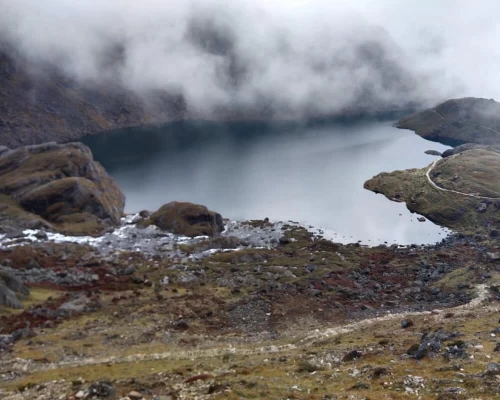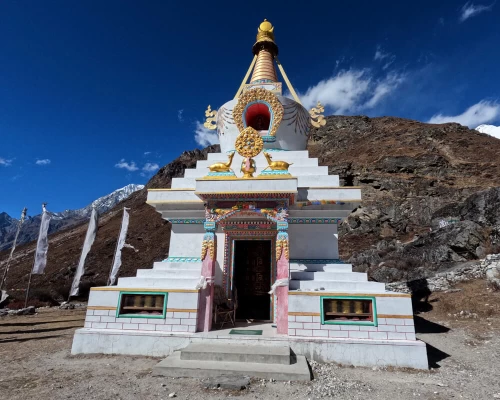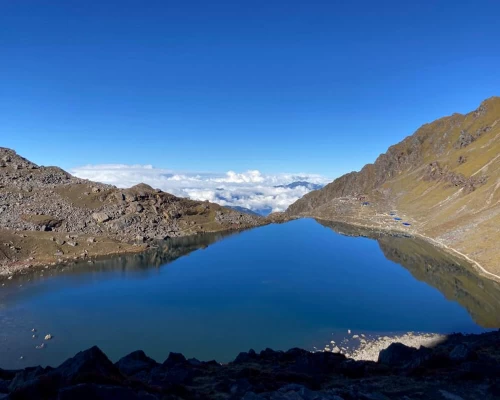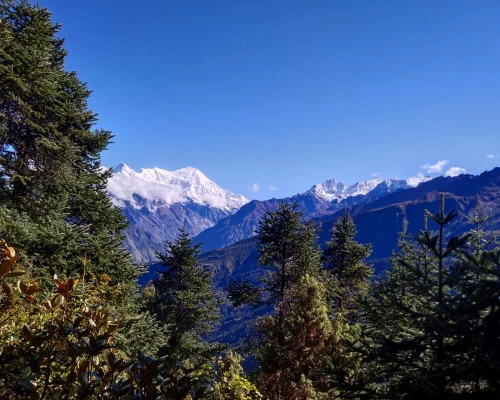Gosaikunda Lake Trekking Introduction
The Gosaikunda trek is one of Nepal's most adventurous and spiritually filled trails. It attracts visitors and pilgrims worldwide, making it a top destination to travel to in 2024/25. The walk through the glaciers, alpine forests, and terraced agriculture fields with the magnificent views of snow-capped mountains mesmerizes anyone who decides to travel here.
The Gosaikunda hike comes under the Langtang region of Nepal. Langtang Valley lies in the Rasuwa district of Nepal, northeast of the Kathmandu Valley, with a surface area of about 13.4ha or 34 acres. It was designated a Ramsar site on 29 September 2007.
Gosaikunda trek is not just about the main lake; many exotic glacier lakes of different sizes are spread around the Gosaikunda region with glorious mountains, verdant forests, stunning landscapes, and natural scenery around. Likewise, the beauty of Gosaikunda Lake, accompanied by the Langtang region's geography, portrays Nepal's natural grandeur.
The tranquil lake surrounded by the Himalayan realm, including Langtang, Manaslu, Annapurna, Ganesh Himal, and Dhaulagiri, is a sight that hypnotizes all the visitors for a while.
According to the myth, the Gosaikunda Lake was formed when the Hindu God Shiva (God of destruction) forced his trident into the mountain to quench his thirst.
Thus, it is believed that the lake has spiritual qualities, and bathing in the water from the lake is said to wash away human sin. Similarly, according to Hindu mythology, Gosaikunda is said to be the abode of the god Shiva and Gauri.
It is believed that the Gosaikund lake was formed when Lord Shiva thrust his trident into the mountain to drink water. Thus, the waters are of particular significance during the Janai Purnima festival in August, when thousands of pilgrims gather under the full moon.
Many Hindu scriptures, like Ramayan, Mahabharat, Bhagwat Puran, and Vishnu Puran, refer to Samundra Manthan, which is related to the origin of Gosaikunda and was explained so well.
This has carried much religious significance that is related to Hindu people and still provides positive persuasion towards them rather than others. Similarly, for this particular reason, many national and international individuals mark Gosaikunda as a major trekking destination in Nepal.
Likewise, Gosaikunda Lake is one of the pilgrimage places for all Hindu Buddhists; once a year, all the devotees from many places in the country, and even the Indian Hindus, come to take a holy dip in the lake. For almost half of the year, it gets frozen. Gosaikunda Lake is the mainspring of the Trishuli River after it melts and spills down the mountain.
However, compared to the Everest Base Camp and Annapurna Base Camp trek, the Gosaikunda Lake trek is quite easy. This enhances the opportunity to separate from the hustle and bustle of the crowded trekking routes and enables one to get closer to nature. Similarly, the views of the snow-capped mountains are as grand as any other trekking region of Nepal.
Similarly, many plant and animal species are explored near, including the red panda, snow leopard, and endangered musk deer, which find the lakes their home. Rhododendron, oak, and pine trees cover the rest of the surrounding forests, which makes it a beautiful, mesmerizing spot for nature lovers.
This journey gives me an excellent opportunity to learn about the local way of life. However, no aquatic life is present in Gosaikunda Lake, even though it is a freshwater lake. The reason is that fish and other marine creatures struggle to survive due to high altitudes and temperatures.
Apart from the lake, the region's cultural richness is another major highlight of the trek. The Langtang region, especially the Gosaikunda area, is inhabited by the Tamang, Gurung, Brahmins, and Chettri, who have distinct languages, cultures, dress, and social structures. As there is a diverse culture in the area, visitors get a chance to immerse themselves in the diverse cultural and traditional way of life.
Expectations on this Trek
As you approach Gosaikunda, plan on an experience that will provide you with a sense of accomplishment, cultural immersion, and breathtaking scenery. Set out on a journey that combines adventure and spirituality with the Gosaikunda trek.
A soul-stirring adventure among glaciers, alpine forests, and terraced farms with breathtaking views of snow-capped peaks awaits those who go on this trip, which is one of Nepal's most intriguing. Encircled by the magnificent Himalayan backdrop of Langtang, Manaslu, Annapurna, Gaurishankar, Ganesh Himal, Himchuli, and Dhaulagiri, the jewel in the crown.
Gosaikunda Lake opens up as you travel in the Langtang region. Gosaikunda Lake is an oligotrophic lake with an altitude of 600 meters. There are several ponds, such as Bhairav Kunda, Saraswati Kunda, Parvati Kunda, and Aama Kunda, which stand among others.
The Gosaikunda lake area is considered to have 108 ponds close to the Ramasar site Lord Shiva is credited with the lake's mythical beginnings, which give it a spiritual edge Bathing in the lake's holy waters is thought to purify oneself Being less crowded than popular routes like Everest and Annapurna Base Camps, this trip offers a peaceful experience of contact with nature, which makes it distinct.
During the Goshaikunda trek, trekkers can walk through the beautiful Rhododendron and pine forests, as well as gain knowledge about creatures like Red Panda, Musk Deer, and the shy mammal species like Habre, etc..
Enjoy the rich cultural diversity of the Gurung, Tamang, Brahmin, and Chettri people and become fully immersed in their customs Trekkers can explore Tamang culture and religious values by talking with friendly local people Likewise, there are local monasteries and one of them is Sing Gompa, which is called as Chandanbari They can visit there, light the butter lamp and feel the peace in your soul People can see the typical nepali culture and local communities, along with their lifestyle.
Visitors can enjoy homemade Nepali food and visit the local food factories in the same area. In the context of accommodation, the trekkers can see the many teahouses and guesthouses near that area. The tea house is not very expensive compared to the guest house.
Lastly, we can visit the Langtang National Park, which has a massive diversity of species. The park is inhabited by some rare, exotic, and threatened animals, including red panda and a leopard; there are 46 species of mammals, including Himalayan thar, wild boar, musk deer, Ghoral, grey langur monkey, Himalayan brown monkey, Musk deer and many more.
In addition, there are exotic species of butterflies and varietal species of birds, such as the Impeyan pheasant, Ibis bill, Snow partridge, and Crimson-horned pheasant, that hover around the park. During the spring season, we can get a chance to see red, white, and pink rhododendron blossoms alongside oak, laurel, blue pine, sal, and Castanopsis indica.
Similarly, an extravagant display of wildflowers can be seen during autumn. A lifetime of memories can be made on the Gosaikunda journey, which promises an incredible fusion of spiritual resonance, breathtaking natural beauty, and cultural immersion, giving the opportunity to be away from stress and enjoy nature for a while.
Who can do the Gosaikunda Lake trek?
Trekking fans of all fitness levels can enjoy this. Everybody with an average fitness level can do the Gosaikunda Trek in a group, as a family, or solo.
Mainly, people are eager to explore, like nature lovers, photographers, peace lovers, etc. Both novice and expert hikers can have the route customized.
Ready for the Gosaikunda Lake trek experience?
One needs to recognize the distinctive cultural and environmental characteristics of the Langtang Gosaikunda walk while mentally and emotionally preparing for the adventure.
Sensitivity to Culture:
- Honor regional traditions and customs.
- Showing good behavior and using polite language.
- Avoid hampering the natural species.
- Engage in conversation with the nearby townspeople.
Environmental Responsibilities:
- Observe the "Leave No Trace" guidelines.
- Cut back on single-use plastics.
Why choose us for the Gosaikunda Lake Trek?
- Nature Excursion guarantees a memorable and responsible trekking experience, thanks to its dedication to safety, skilled guides, and emphasis on sustainable tourism. There are various reasons why Nature Excursion is unique and guarantees an unmatched trekking experience.
- Our knowledgeable guides, who have lived in the Langtang region for many years, can offer valuable insights into the local way of life, natural history, and wildlife.
- The trips have as little ecological impact as possible due to our dedication to sustainable and ethical tourism methods.
- Trekkers' safety is ensured by following international safety regulations, using qualified guides, and following emergency procedures.
- Through the community engagement programs, trekkers can fully immerse themselves in the local way of life with the Langtang locals.
- We provide more managed hospitality by fulfilling their needs and treating them as excellent guests.
- We provide the best and most accurate information.

.webp)
.webp)







